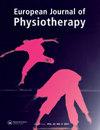Exergames to improve rehabilitation after knee arthroplasty: a systematic review and grade evidence synthesis
IF 1.1
Q3 REHABILITATION
引用次数: 0
Abstract
Abstract Objective We aimed to systematically review and synthesise the impact of rehabilitation with games in people after knee arthroplasty. Methods We conducted a systematic review following the Preferred Reporting Items for the declaration of Systematic Reviews (PRISMA – Preferred Reporting Items for Systematic Reviews and Meta-Analysis). The summary of evidence was developed using the Grading of Recommendations, Assessment, Development, and Assessment (GRADE). The review included randomised controlled trials that used characteristics of games in rehabilitation. Results Eight articles from a total of 1289 identified articles were included after duplicates were removed. In total, 239 participants participated. There were no statistically significant changes between the groups using the exergames and control groups. The level of evidence was rated using GRADE and was very low or moderate. The difference in grouped means was not significant for Knee Flexion, Knee extension, Range of Motion, WOMAC (Western Ontario and McMaster Universities Arthritis Index), AKSS (American Knee Society Score), Self-Efficacy, Five Times Sit-to-Stand Test time, Pain, or Proprioception. Conclusions The results of the different studies did not find significant changes in the intervention groups with exergames in the physical domains, especially in studies with shorter interventions. Therefore, further investment in future studies on developing and evaluating games is suggested to enhance training during the recovery process.运动改善膝关节置换术后的康复:系统回顾和分级证据综合
本文章由计算机程序翻译,如有差异,请以英文原文为准。
求助全文
约1分钟内获得全文
求助全文

 求助内容:
求助内容: 应助结果提醒方式:
应助结果提醒方式:


